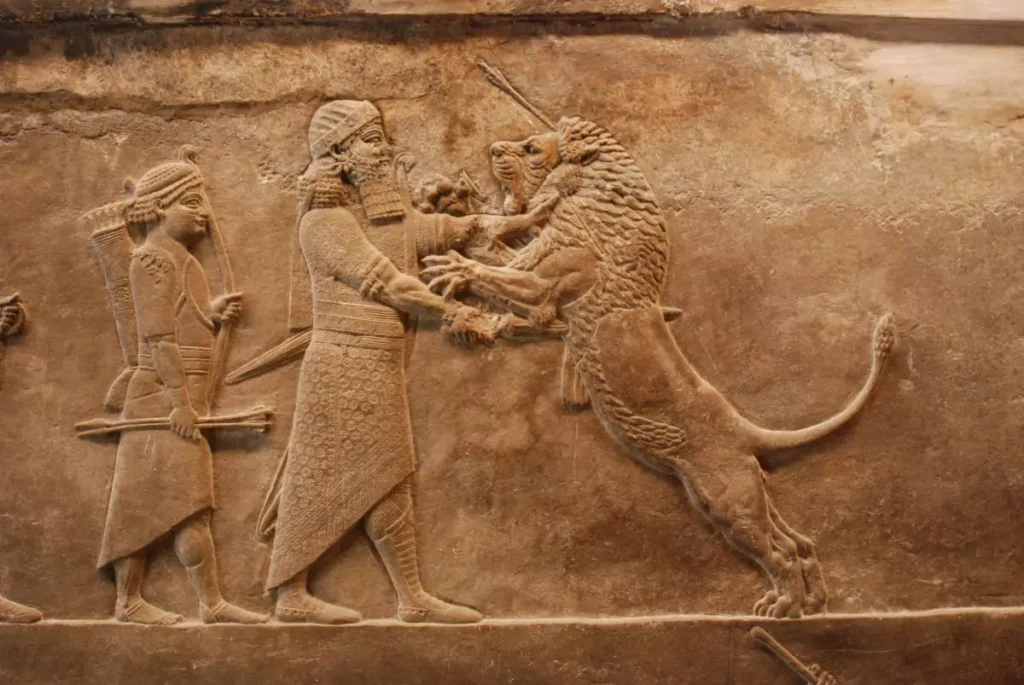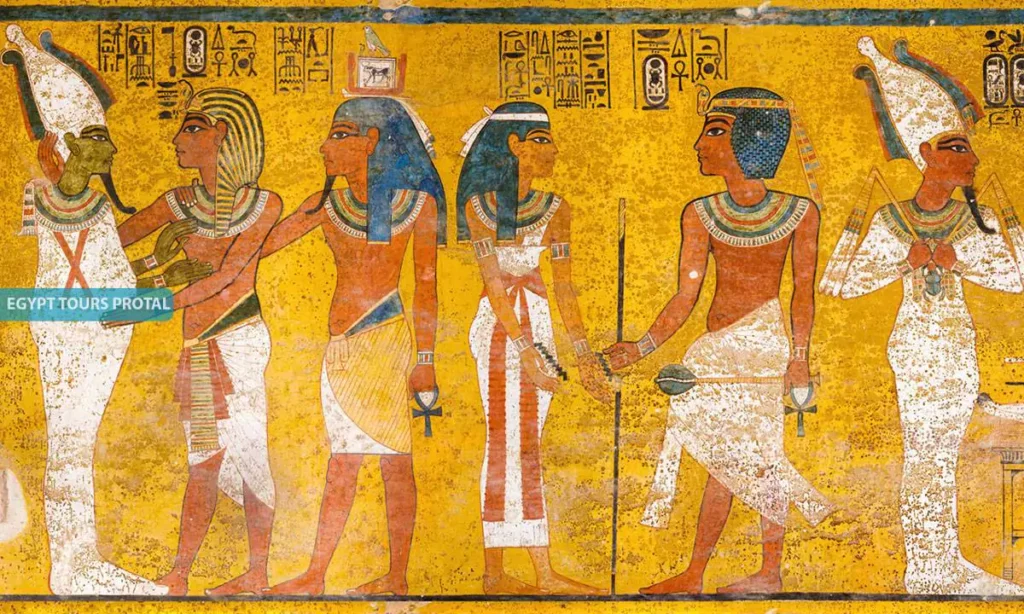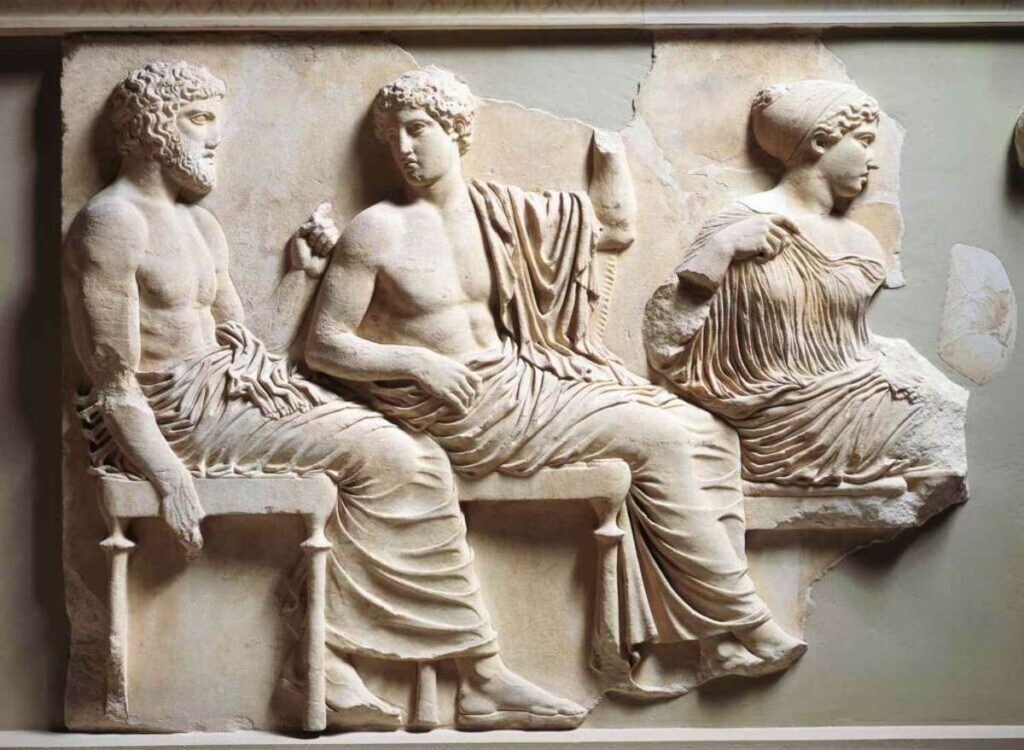Many people love to learn about history. The Venus of Willendorf is the oldest known sculpture. Our blog will show you the beauty of “Ancient Artz”. Get ready for a journey back in time.
Key Civilizations in Ancient Artz
Key Civilizations in Ancient Artz shaped human history and creativity. Mesopotamian, Egyptian, Greek, and Roman art offered unique perspectives on life and culture that continue to inspire us today.
These ancient civilizations left behind a rich legacy of artistic mastery that continues to unveil timeless treasures for modern creativity.
Mesopotamian Art: The Cradle of Civilization

Mesopotamian art started around the Ziggurat of Ur in 2100 BCE. This massive structure stood 70 feet tall. Artists honored gods and rulers through their work. They made stone carvings and built big ziggurats.
Their petroglyphs showed simple shapes, human figures, and told stories.
They used stone, clay, metal, wood, and natural pigments to create their art. Techniques like bas-relief carving and metalwork were common. Mesopotamian culture left a big mark on modern design and thinking about art.
Egyptian Art: Eternity in Stone

Egyptian art started around 3,000 BCE during the Old Kingdom. This art is special because it was made to last forever. The Pyramids of Giza, built between 2580 and 2560 BCE, are big examples of this.
They show how pharaohs wanted people to see them as gods on earth.
Artists used over 700 hieroglyphics since about 3,200 BCE to tell stories and honor gods. These symbols helped combine writing with pictures for a powerful effect. Art often focused on religion and ceremonies which were key parts of Egyptian culture.
In ancient Egypt, artists created with eternity in mind, building monuments that stand as testaments to their civilization’s grand vision.
Greek Art: The Birth of Classical Ideals

Moving from the timeless stone structures of Egypt, we enter the era of Greek art. It is known for shaping classical ideals around 5th century BCE. This period gave us lifelike sculptures that show the ideal human form.
One key figure in this movement was Phidias, a master sculptor whose work set the standards for beauty and proportion.
Greek artists excelled in marble sculpture and fresco painting. They built architectural marvels like the Parthenon between 447 and 432 BCE. This temple stands as a testament to their love for geometry, balance, and harmony.
Greek art has left its mark on many aspects of modern life including sports and aesthetics, echoing through time with its emphasis on classical beauty.
Roman Art: Realism and Grandeur

Transitioning from the birth of classical ideals in Greek art, Roman art exuded realism and grandeur. Influenced by Greek styles, ancient Roman artists excelled in creating realistic sculptures using stone and marble.
Mosaics, a hallmark of Roman art, gained popularity around 2nd century BCE and were crafted with intricate designs using natural pigments. The construction of the iconic Colosseum was completed in 80 CE, showcasing the grand architectural prowess of ancient Rome.
Techniques like mosaic crafting and fresco painting emerged as innovative methods employed by Roman artisans to adorn public spaces as a form of mass communication.
Roman art incorporated materials such as clay for sculpting and various natural pigments for coloration. This artistic tradition paved the way for expansive public artworks throughout ancient Rome’s urban landscape.
Asian Art: Spirituality and Nature

Asian art deeply connects to spirituality and nature. Chinese traditional art particularly embodies these themes. Chinese artists employed various mediums like calligraphy and silk painting to express spiritual concepts and the harmony between humanity and nature.
One notable example of this is the Terracotta Warriors, around 8,000 life-sized soldiers created for Emperor Qin Shi Huang’s tomb in China. In addition, ancient rock art from Saharan Africa also mirrors the intertwining of spirituality and nature with its age-old depictions.
The special significance of healing properties attributed to Chinese art further emphasizes its mystical connection to spirituality and nature. Notably, influential artist Zhang Daqian has made remarkable artistic contributions by integrating these profound themes into his works that continue to influence modern perceptions of Eastern artistry.
Turning to “Techniques and Materials in Ancient Artz”…
Techniques and Materials in Ancient Artz
Ancient artisans used a variety of materials and techniques to create their masterpieces. Understanding these methods offers a glimpse into the ingenuity and skill of ancient artists.
Common Materials Used in Ancient Artz
Artisans in ancient times used a variety of materials to create their masterpieces. These materials influenced the durability and preservation of the artwork. Here are some common materials used in ancient art:
- Stone: Widely used for monumental sculptures and architecture, such as the Egyptian pyramids, Greek temples, and Mayan ruins.
- Clay: Utilized for pottery and sculpting, prevalent in cultures such as the Mesopotamians and Greeks.
- Metal: Found in intricate metalwork using bronze and goldsmithing techniques, reflecting skilled craftsmanship.
- Wood: Used for carving sculptures and creating everyday objects like furniture, showcasing an array of artistic expressions.
- Natural Pigments: Ochre and indigo were commonly employed to add vibrant colors to paintings, frescoes, and textiles.
- Textiles: Weaving techniques using natural fibers like linen played a significant role in tapestries and clothing adorned with natural dyes.
These traditional materials not only defined ancient art but continue to inspire modern creators through their timeless beauty and historical significance.
Innovative Artistic Techniques of Ancient Times
Ancient artisans used a variety of innovative techniques and materials to create their masterpieces. From fresco painting to mosaic crafting and bas-relief carving, these traditional methods paved the way for classical art forms.
Early artistic practices portrayed animals, hunting scenes, daily life, and spirituality through petroglyphs that depicted geometric patterns and human figures. Greek art focused on lifelike sculptures portraying the ideal human form, while Roman artists excelled in advanced mosaic crafting techniques.
Chinese art showcased intricate calligraphy and delicate silk painting as part of their time-honored craftsmanship.
These ancient artistic approaches still hold relevance today in understanding the historical development of art styles across different civilizations. The vintage methods and materials used by early artisans continue to inspire contemporary artists seeking timeless artistic processes.
Themes and Symbolism in Ancient Artz
4. Themes and Symbolism in Ancient Artz explore the deep-rooted religious and mythological themes, as well as the intricate symbolism that significantly shaped ancient artworks. These timeless treasures are windows into the cultural beliefs and values of centuries-old civilizations, offering a glimpse into their artistic mastery and storytelling traditions.
Religious and Mythological Themes
Ancient art was deeply intertwined with religious and mythological themes, serving as a medium to express spiritual beliefs and myths. In Egyptian art, pharaohs were depicted with divine status, while Mesopotamian art honored gods and rulers.
The ancient Chinese artworks were believed to possess healing properties. Pre-Columbian civilizations like the Mayans and Aztecs incorporated religious and astronomical motifs into their ceremonial art.
Temples, pyramids, and shrines stood as significant religious centers in various cultures, manifesting the importance of sacred architecture in ancient societies.
Artworks from these ancient civilizations often portrayed mythical symbolism and religious iconography that reflected their cultural beliefs. Whether in the depiction of divine rulers or astronomical motifs representing mystical connections, ancient art was underpinned by spirituality and a reverence for the supernatural.
Symbolism in Ancient Artz
Symbols played a significant role in ancient art, reflecting cultural beliefs and values. In Egyptian hieroglyphics, symbols were used to convey words and ideas, deeply rooted in religious and mythological themes.
Greek art depicted symbolism through ideal human forms and mythology, serving as a window into their societal ideals. Petroglyphs featured geometric patterns and human figures, showcasing artistic symbolism passed down through generations.
The pottery and seals of the Indus Valley displayed symbolic designs that held meaning within their culture. Even Olmec colossal heads from 1200–400 BCE carried symbolic significance, possibly representing rulers or deities.
Overall, ancient artwork across various civilizations reflected societal struggles, triumphs, and core values through intricate symbolism.
Cultural Significance of Ancient Artz
Ancient art holds immense cultural significance, reflecting the beliefs, values, and daily lives of ancient civilizations. It provides a window into the past, giving us a deeper understanding of our ancestors’ creativity and mastery in various art forms.
Through ancient art, we can appreciate the rich legacy left behind by these civilizations and gain insights into their societal structures and historical developments.
Influence on Modern Culture and Art
Ancient art has left a lasting imprint on modern culture and art. From Greek influences on sports and aesthetics to inspiring contemporary artists, its impact is significant. The integration of Roman art with Greek influences showcases how ancient art continues to connect the past with the present, giving rise to cross-cultural exchanges and artistic inspiration in modern design.
Moreover, modern conservation techniques are crucial for preserving ancient art as it serves as a source of historical significance and aesthetic principles for contemporary creations.
The significance of ancient art lies in its relevance today, maintaining cultural connections while serving as an inspiration for contemporary design. This influence can be observed in various forms across different disciplines such as architecture, painting, and sculpture.
Furthermore, these timeless masterpieces have sparked cross-cultural exchanges that still resonate in the global artistic landscape today.
Educational Value in Studying Ancient Artz
Studying ancient art offers a unique insight into historical cultures and societies. Through these artworks, one can comprehend the values, understandings, and experiences of ancient civilizations.
Museums play a crucial role in promoting educational programs that allow people to appreciate the allure of ancient art and understand its cultural significance. Furthermore, digital platforms have renewed interest in ancient art by engaging audiences through interactive features and captivating content.
Ancient art provides a window into history and allows for interpretations based on societal struggles, triumphs, and everyday life. By learning about ancient artifacts in museums or exploring them through digital platforms, individuals gain direct experience of the cultural heritage embodied in these timeless masterpieces.
This not only enhances public engagement but also fosters an understanding of how art reflects human experiences across different periods of history.
Preservation and Challenges
In preserving ancient art, various methods have been developed over time. These preservation efforts face numerous challenges due to the fragility and age of the artworks.
Methods of Preserving Ancient Artz
Modern techniques used to preserve ancient art include:
- Conservation methods such as restoration processes and preservation techniques maintain the integrity of ancient artifacts.
- Specific environmental conditions are required for the proper preservation of ancient art, ensuring its longevity and protection against deterioration.
- Technology aids in preservation and restoration by providing non-invasive methods that help conserve cultural heritage through digital archiving and documentation.
- Preservation technology continues to evolve, with increasing emphasis on digital platforms to engage audiences and renew interest in ancient art.
Challenges in the Preservation of Ancient Artz
Preserving ancient art presents various challenges and requires specific environmental conditions. The limited funding for preservation projects has led to deterioration due to time and exposure. Here are some detailed challenges faced in preserving ancient art:
- Environmental Damage: Exposure to fluctuating temperatures, humidity, and air pollution deteriorates artifacts.
- Looting: The illegal excavation and trade of antiquities contribute to the loss of cultural heritage.
- Limited Funding: Preservation projects often struggle with insufficient financial support, hindering conservation efforts.
- Deterioration: Artifacts degrade over time, requiring skilled conservators and restorers for maintenance.
- Skilled Personnel: There’s a need for professionals with specialized knowledge in art conservation and artifact preservation.
- Balancing Accessibility: Ensuring public access while safeguarding artifacts is crucial but challenging due to potential damage risks.
- Cultural Significance: Preserving ancient art is essential for maintaining cultural heritage and historical preservation efforts.
These challenges underscore the complex nature of conserving ancient art and emphasize the need for innovative solutions to ensure its longevity.
Ancient Artz in Modern Spaces
Ancient art finds its place in modern spaces, gracing architecture and interiors with timeless treasures. Integrating historical masterpieces brings a touch of cultural significance to contemporary settings.
Display and Integration in Modern Architecture
Ancient art is being revitalized in contemporary architectural designs. Museums, public spaces, and even private buildings are integrating ancient artifacts, showcasing their historical influence.
Modern design intentionally incorporates these pieces to connect with the past while enriching the present. Replicas play a crucial role in preserving originals, making art accessible via digital archives.
The allure of ancient art enhances modern spaces and encourages a deeper appreciation for its artistic value.
The contemporary display of ancient artifacts supports the influence on architecture while ensuring preservation through replicas and digital accessibility.
Reproductions and Their Role Today
Reproductions play a crucial role in making ancient art more accessible to a wider audience. They are used to preserve the original artworks while allowing people to experience and appreciate them.
Museums often utilize replicas for interactive exhibits, and digital reproductions engage with modern audiences, ensuring that cultural heritage is not confined to physical spaces.
Moreover, educational institutions incorporate reproductions into their curriculum, providing students with hands-on experiences of historical artifacts that may otherwise be inaccessible.
Beyond preservation, these copies serve as essential tools for learning and cultural enrichment.
Ancient Artz in Modern Spaces continue…
The Future of Ancient Artz
The future of ancient art holds exciting potential with technological advances in archaeology and art preservation. Increasing public engagement and interest are driving a renewed appreciation for these timeless masterpieces.
Technological Advances in Archaeology and Art Preservation
Archaeology and art preservation are benefiting from technological innovations. These advancements include nondestructive analysis, digital reconstruction, artificial intelligence in restorations, and improved methods for dating and authenticating artifacts.
Radiocarbon dating has become more precise, while remote sensing technology aids in the discovery of archaeological sites. Cultural heritage preservation now incorporates virtual reality experiences and 3D scanning for artifact reconstruction.
These tools engage audiences with ancient artifacts on digital platforms while renewing public interest in cultural history.
Increasing Public Engagement and Interest
Enhancing public interest in ancient art is crucial for its preservation and appreciation. Museums are utilizing online platforms and interactive displays to cultivate curiosity. Educational outreach, workshops, and social media engagement are fostering community involvement and renewing public interest.
Encouraging participation through digital platforms engages audiences and enhances their understanding of ancient art’s allure. Interactive exhibits in museums inspire curiosity while social media communities facilitate educational programs, thus fostering engagement among the public.
Conclusion
Step into the captivating world of ancient art and discover the timeless masterpieces crafted by ancient civilizations. Unveil the hidden gems that hold centuries-old cultural significance and artistic mastery.
Explore how these historical artworks continue to influence modern creativity and stand as a testament to humanity’s rich heritage. The legacy of ancient art continues to inspire, educate, and mesmerize us, bridging the gap between the past and present.
FAQs
-
What is “Ancient Artz: Dive Into History With Timeless Masterpiece”?
“Ancient Artz” is an exploration of historical art pieces. It invites viewers to appreciate timeless masterpieces from various cultures and eras.
-
Why should I explore ancient art?
Exploring ancient art helps you understand history better. It connects you with past civilizations and their stories through visual expressions.
-
How can I experience the exhibition?
You can visit galleries hosting “Ancient Artz.” Many museums offer guided tours, interactive displays, or online resources for a deeper understanding of the artworks.
-
Is there educational content available about these masterpieces?
Yes, many exhibitions provide educational materials. You can find books, documentaries, and lectures that discuss the significance of each masterpiece in detail.

